Selective Carbon Enrichment from Micro/Nano Silicon–Carbon Ores via Sodium Hexametaphosphate: Mechanistic Insights and Structural Characterization
Abstract
:1. Introduction
2. Materials and Methods
2.1. Experimental Raw Materials and Equipment
2.2. Sample Preparation
2.3. Testing and Analysis Methods
3. Results and Discussion
3.1. Exploration of Grinding and Separation Mechanism of Silicon–Carbon Ore
3.2. Characterization and Identification of Carbonaceous Materials in Silicon–Carbon Ore
3.3. Textural Analysis of Carbonaceous in Silicon–Carbon Ore and Its Application Prospects
4. Conclusions
Author Contributions
Funding
Data Availability Statement
Acknowledgments
Conflicts of Interest
References
- Tang, S.W.; Shuai, H.; Zhao, R.T.; Du, G.X.; Wang, X.G.; Wang, J. Process Mineralogy of Micro/Nano Silicon-Carbon Ore Obtained from Jiangxi, China. Minerals 2022, 12, 700. [Google Scholar] [CrossRef]
- Kowalczuk, P.B.; Zaleska, E.; Danczak, O. Flotation of carbonaceous copper shale-quartz mixture with poly(ethylene glycol) alkyl ethers. Trans. Nonferrous Met. Soc. China 2015, 25, 314–318. [Google Scholar] [CrossRef]
- Reis, M.; Machado, M.J.C. An ultrasonic method for the separation of carbonaceous material from schists for the determination of graphitization degree by x-ray-diffraction. Chem. Geol. 1992, 100, 191–199. [Google Scholar]
- Wang, Y.; Chen, X.; Hu, Y.; Lan, Y. Influences of phosphates on dispersion of fine alumin-silicate minerals. J. Cent. South Univ. Sci. Technol. 2007, 38, 238–244. [Google Scholar]
- Liu, C.P.; Wang, W.Q.; Sun, J.R.; Liu, L. Effect of sodium hexametaphosphate on the separation of fine quartz-magnetite by magnetic separation: A study of dispersion properties and mechanism. Sep. Purif. Technol. 2025, 359, 130352. [Google Scholar] [CrossRef]
- Zhang, H.Q.; Zhou, F.; Yu, H.; Liu, M.X. Double roles of sodium hexametaphosphate in the flotation of dolomite from apatite. Colloid Surf. A-Physicochem. Eng. Asp. 2021, 626, 127080. [Google Scholar] [CrossRef]
- Gaffney, T.R. Porous solids for air separation. Curr. Opin. Solid State Mater. Sci. 1996, 1, 69–75. [Google Scholar] [CrossRef]
- Liang, C.; Li, Z.; Dai, S. Mesoporous Carbon Materials: Synthesis and Modification. Angew. Chem. Int. Ed. 2008, 47, 3696–3717. [Google Scholar] [CrossRef]
- Ma, T.-Y.; Liu, L.; Yuan, Z.-Y. Direct synthesis of ordered mesoporous carbons. Chem. Soc. Rev. 2013, 42, 3977–4003. [Google Scholar] [CrossRef]
- Wang, Y.; Li, Z.H.; Wang, J.; Li, J.H.; Lin, Y.H. Graphene and graphene oxide: Biofunctionalization and applications in biotechnology. Trends Biotechnol. 2011, 29, 205–212. [Google Scholar] [CrossRef]
- Hu, Z.; Srinivasan, M.P. Mesoporous high-surface-area activated carbon. Microporous Mesoporous Mater. 2001, 43, 267–275. [Google Scholar] [CrossRef]
- Biener, J.; Stadermann, M.; Suss, M.; Worsley, M.A.; Biener, M.M.; Rose, K.A.; Baumann, T.F. Advanced carbon aerogels for energy applications. Energy Environ. Sci. 2011, 4, 656–667. [Google Scholar] [CrossRef]
- Liu, B.; Liu, L.; Yu, Y.; Zhang, Y.; Chen, A. Synthesis of mesoporous carbon with tunable pore size for supercapacitors. New J. Chem. 2020, 44, 1036–1044. [Google Scholar] [CrossRef]
- Zhao, P.; Wang, L.; Sun, C.; Jiang, T.; Zhang, J.; Zhang, Q.; Sun, J.; Deng, Y.; Wang, S. Uniform mesoporous carbon as a carrier for poorly water soluble drug and its cytotoxicity study. Eur. J. Pharm. Biopharm. 2012, 80, 535–543. [Google Scholar] [CrossRef] [PubMed]
- Yang, S.Q.; Luo, X.P.; Zhou, H.P.; Tang, X.K.; Liu, Z.S.; Guo, J.F.; Shen, L.Y. Effect of sodium hexametaphosphate on the flotation separation of lepidolite and quartz: MD study. Physicochem. Probl. Miner. Process. 2024, 60, 192882. [Google Scholar] [CrossRef]
- Rish, S.K.; Tahmasebi, A.; Yu, J.L. A DSC study on the impact of low-temperature oxidation on the behavior and drying of water in lignite. J. Therm. Anal. Calorim. 2020, 139, 3507–3517. [Google Scholar] [CrossRef]
- Wang, Q.; Wang, G.W.; Zhang, J.L.; Le, J.Y.; Wang, H.Y.; Wang, C. Combustion behaviors and kinetics analysis of coal, biomass and plastic. Thermochim. Acta 2018, 669, 140–148. [Google Scholar] [CrossRef]
- Cheng, X.J.; Shi, L.; Liu, Q.Y.; Liu, Z.Y. Heat effects of pyrolysis of 15 acid washed coals in a DSC/TGA-MS system. Fuel 2020, 268, 117325. [Google Scholar] [CrossRef]
- Huang, H.Y.; Liu, J.Y.; Liu, H.; Evrendilek, F.; Buyukada, M. Pyrolysis of water hyacinth biomass parts: Bioenergy, gas emissions, and by-products using TG-FTIR and Py-GC/MS analyses. Energy Convers. Manag. 2020, 207, 112552. [Google Scholar] [CrossRef]
- Tucureanu, V.; Matei, A.; Avram, A.M. FTIR Spectroscopy for Carbon Family Study. Crit. Rev. Anal. Chem. 2016, 46, 502–520. [Google Scholar] [CrossRef]
- Farias, T.M.B.; Gennari, R.F.; Chubaci, J.F.D.; Watanabe, S. FTIR spectra and TL properties of quartz annealed at high temperatures. In Proceedings of the International Conference on Luminescence and Optical Spectroscopy of Condensed Matter (ICL’08), Lyon, France, 7–11 July 2008; pp. 493–496. [Google Scholar]
- Ohtomo, Y.; Kakegawa, T.; Ishida, A.; Nagase, T.; Rosing, M.T. Evidence for biogenic graphite in early Archaean Isua metasedimentary rocks. Nat. Geosci. 2014, 7, 25–28. [Google Scholar] [CrossRef]
- Hu, S.Y.; Evans, K.; Craw, D.; Rempel, K.; Bourdet, J.; Dick, J.; Grice, K. Raman characterization of carbonaceous material in the Macraes orogenic gold deposit and metasedimentary host rocks, New Zealand. Ore Geol. Rev. 2015, 70, 80–95. [Google Scholar] [CrossRef]
- Henry, D.G.; Jarvis, I.; Gillmore, G.; Stephenson, M. Raman spectroscopy as a tool to determine the thermal maturity of organic matter: Application to sedimentary, metamorphic and structural geology. Earth Sci. Rev. 2019, 198, 102936. [Google Scholar] [CrossRef]
- Beyssac, O.; Goffé, B.; Petitet, J.P.; Froigneux, E.; Moreau, M.; Rouzaud, J.N. On the characterization of disordered and heterogeneous carbonaceous materials by Raman spectroscopy. Spectroc. Acta A Molec. Biomolec. Spectr. 2003, 59, 2267–2276. [Google Scholar] [CrossRef]
- Wopenka, B.; Pasteris, J.D. Structural characterization of kerogens to granulite-facies graphite: Applicability of Raman microprobe spectroscopy. Am. Mineral. 1993, 78, 533–557. [Google Scholar]
- Lespade, P.; Marchand, A.; Couzi, M.; Cruege, F. Caracterisation de materiaux carbones par microspectrometrie Raman. Carbon 1984, 22, 375–385. [Google Scholar] [CrossRef]
- Tuinstra, F.; Koenig, J.L. Raman Spectrum of Graphite. J. Chem. Phys. 1970, 53, 1126–1130. [Google Scholar] [CrossRef]
- Li, K.; Liu, Q.F.; Cheng, H.F.; Hu, M.S.; Zhang, S. Classification and carbon structural transformation from anthracite to natural coaly graphite by XRD, Raman spectroscopy, and HRTEM (vol 249, 119286, 2021). Spectroc. Acta A Molec. Biomolec. Spectr. 2023, 303, 123247. [Google Scholar] [CrossRef]
- Li, K.; Zhang, H.; Wu, Y.T.; Hu, M.S.; Liu, Q.F. Graphite microcrystals growth in naturally graphitized coal from Hunan, China. J. Cryst. Growth 2022, 582, 126530. [Google Scholar] [CrossRef]
- Fan, Q.W.; Song, C.Y.; Fu, P. Advances in the improvement of the quality and efficiency of biomass-derived porous carbon: A comprehensive review on synthesis strategies and heteroatom doping effects. J. Clean Prod. 2024, 452, 142169. [Google Scholar] [CrossRef]

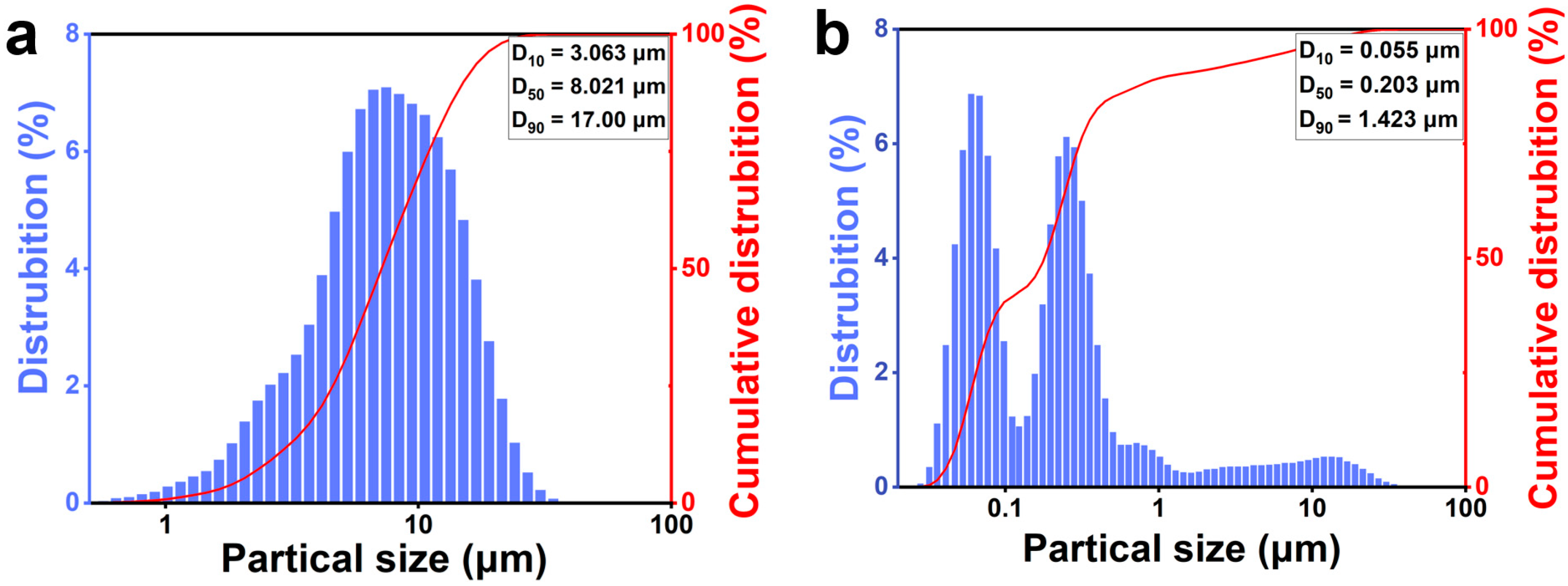
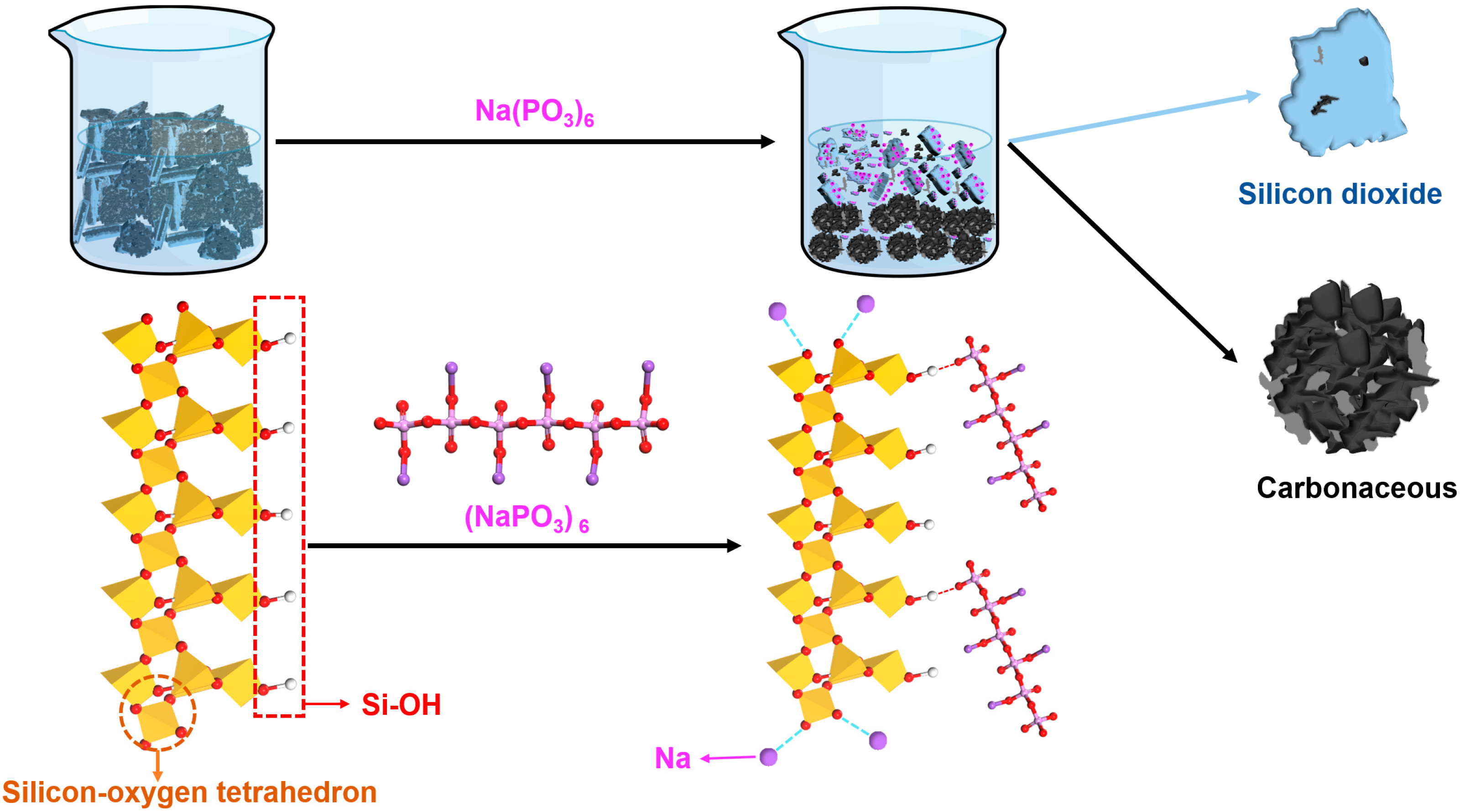

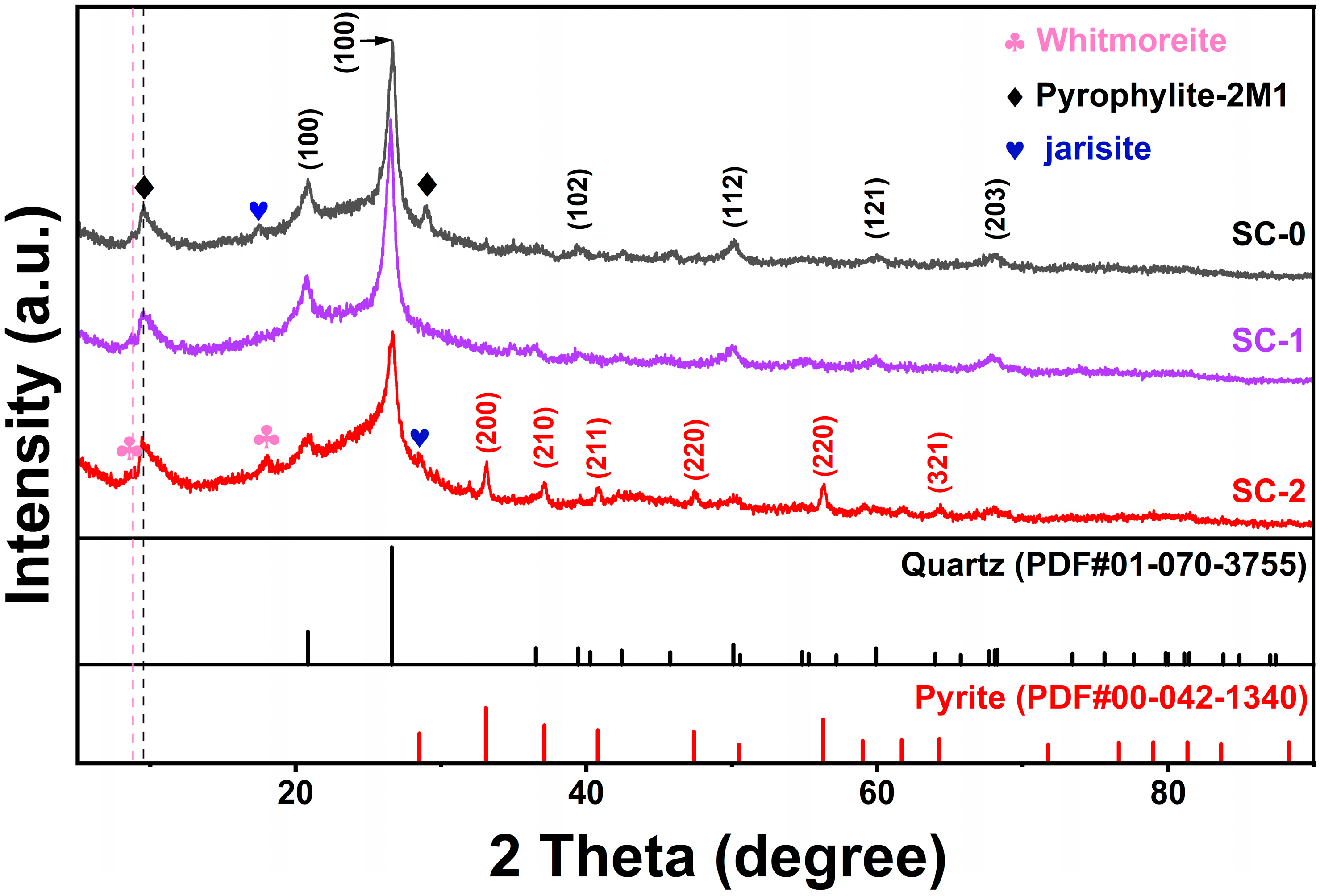
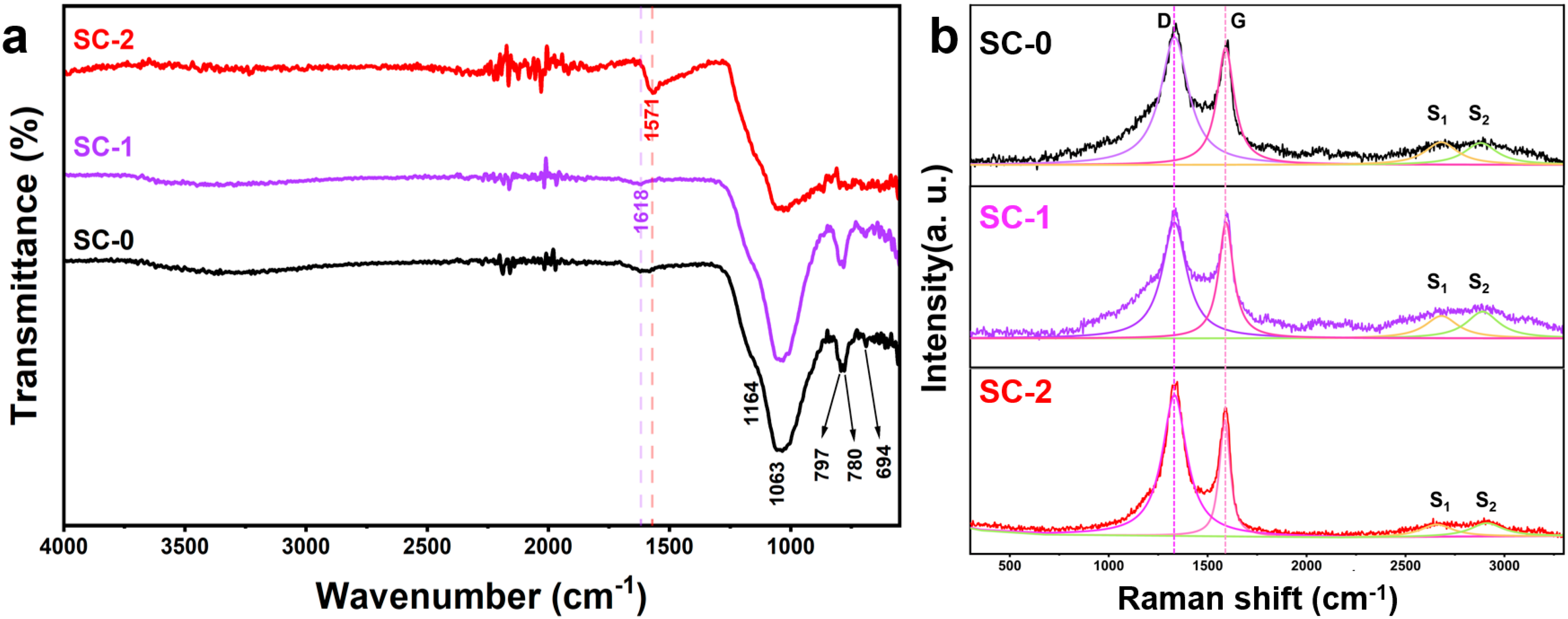
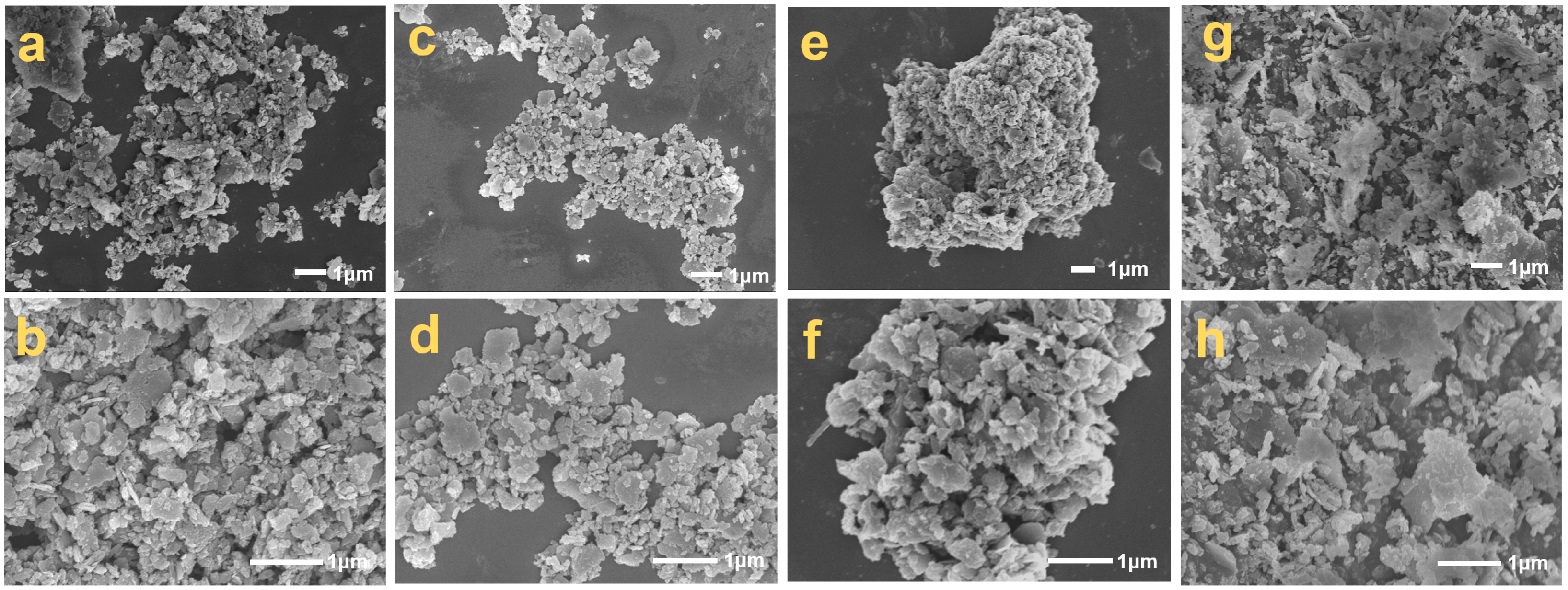
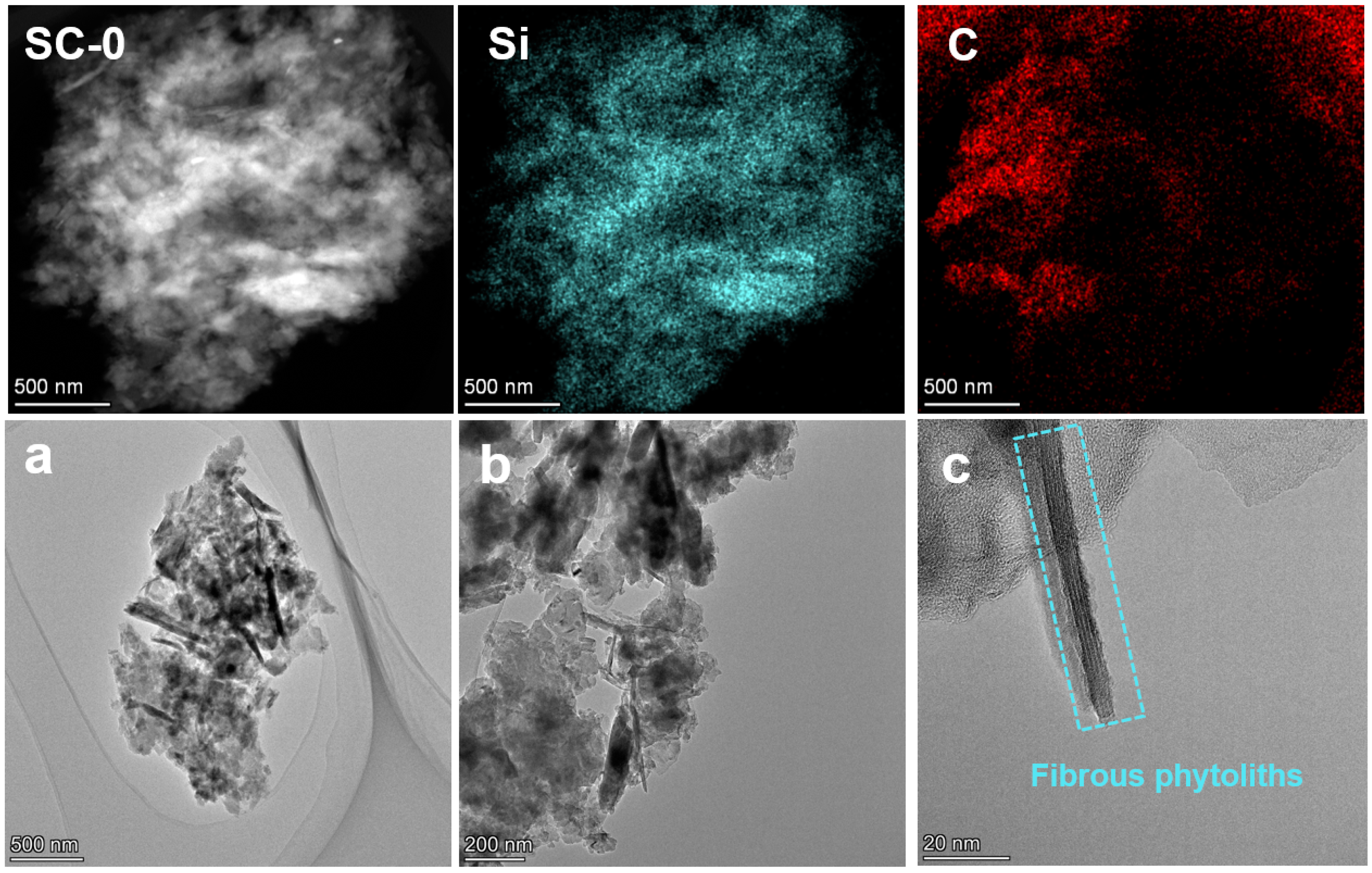
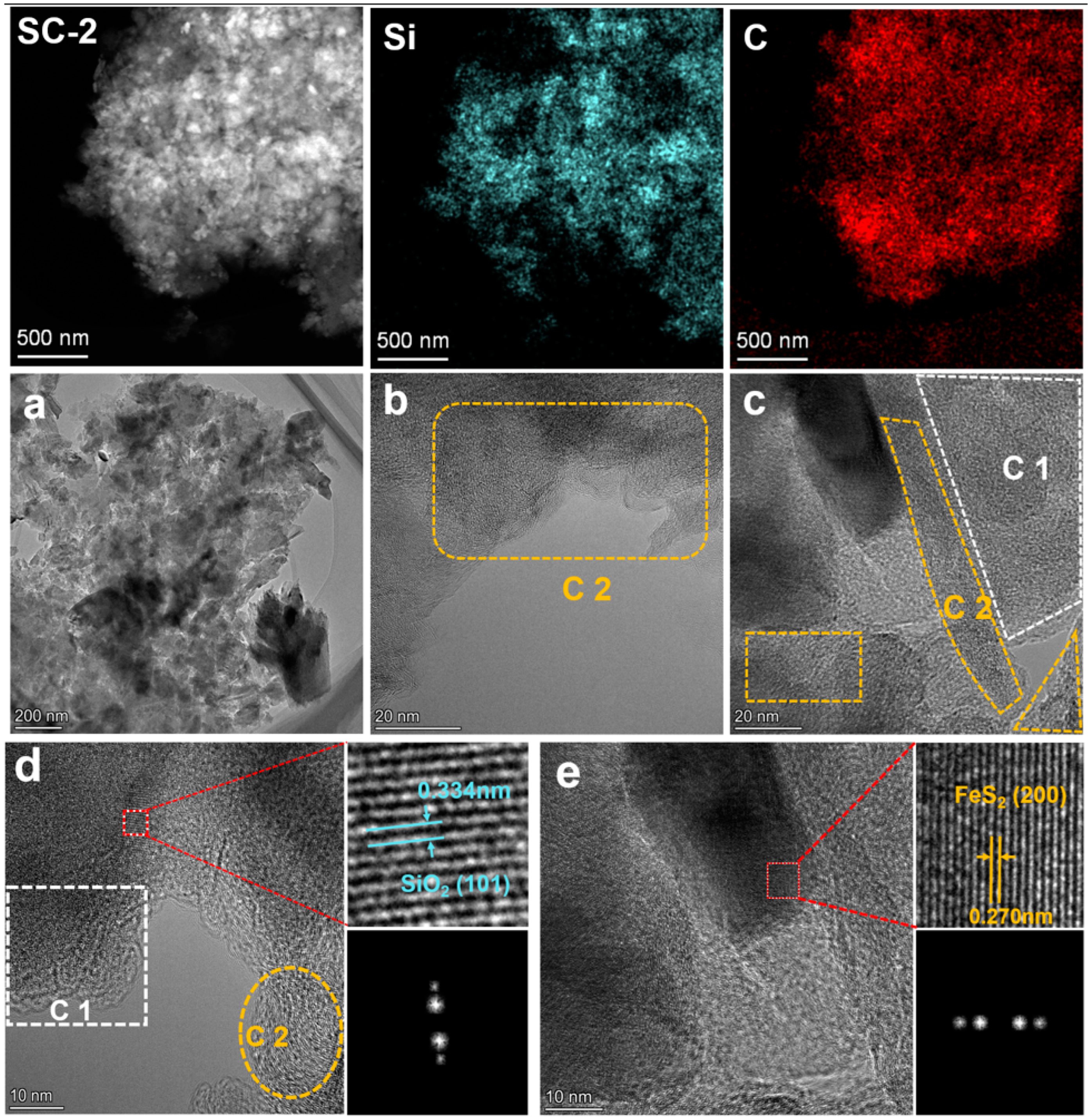
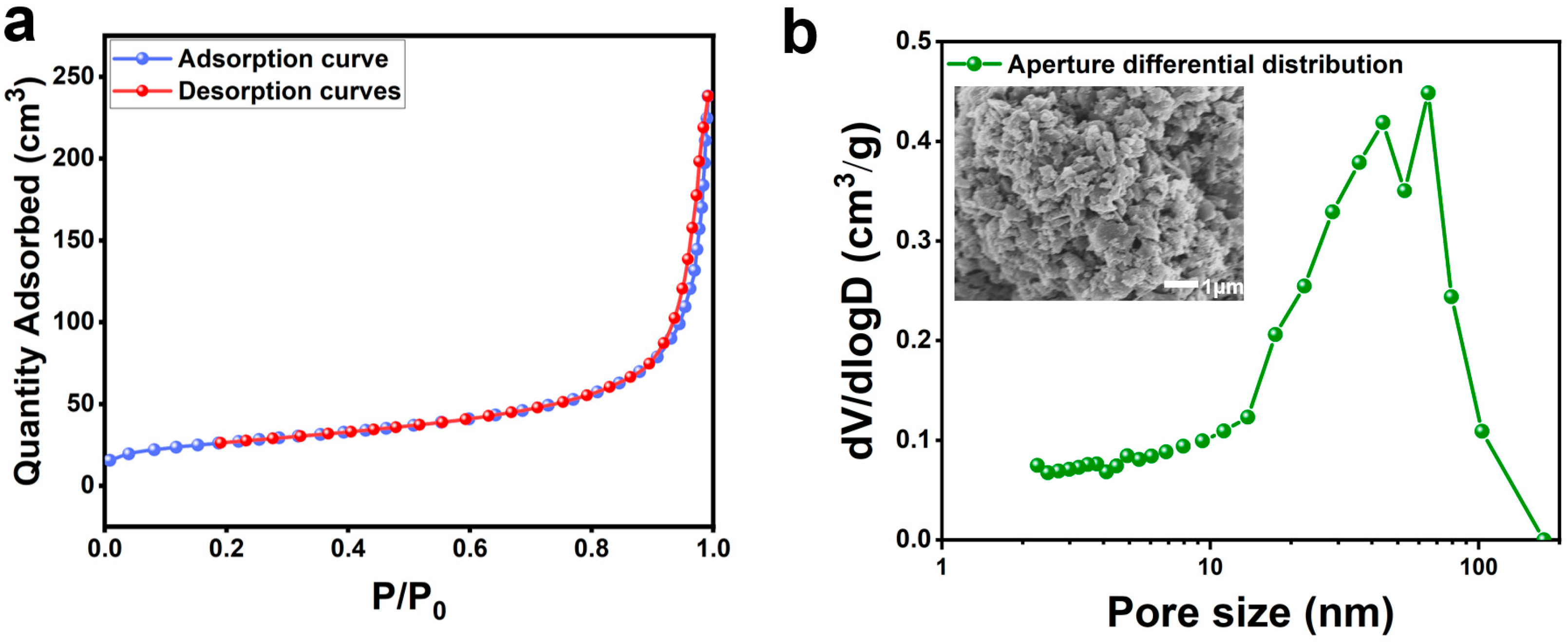
| Abbreviation | Explanation |
|---|---|
| SHMP | Sodium hexametaphosphate |
| SC-0 | Silicon–carbon ore samples after grinding treatment |
| SC-1 | Following SHMP treatment, the upper layer of the gray, silicon dioxide-rich silico-carbon ore sample |
| SC-2 | Following SHMP treatment, the lower layer of the black, carbon-rich silicon–carbon ore sample |
| Sample | ζ Potential (mV) |
|---|---|
| SC-0 | −4.25 |
| SC-0+SHMP | −29.1 |
| Element | SiO2 | Al2O3 | MgO | TiO2 | CaO | K2O |
|---|---|---|---|---|---|---|
| SC-0 | 77.1 | 4.5 | 0.3 | 0.3 | 0.1 | 0.2 |
| SC-1 | 82.8 | 5.5 | 0.4 | 0.4 | 0.2 | 0.2 |
| SC-2 | 26.7 | 1.1 | 0.2 | 0.2 | 0.1 | 0.1 |
| Element | Na2O | Fe2O3 | P2O5 | SO3 | C | Total |
| SC-0 | 0.1 | 2.2 | 0.1 | 2.9 | 12.2 | 100 |
| SC-1 | 0.4 | 1.8 | 0.6 | 0.7 | 7.0 | 100 |
| SC-2 | 0.2 | 2.4 | 0.5 | 6.6 | 61.9 | 100 |
| Sample | Peak | Position/cm−1 | Amplitude | FWHM | Area | R1 | R2 |
|---|---|---|---|---|---|---|---|
| SC-0 | D | 1342 | 630 | 155 | 146.08 | 1.05 | 0.66 |
| G | 1596 | 600 | 80 | 74.26 | |||
| S1 | 2695 | 130 | 300 | 38.51 | |||
| S2 | 2900 | 130 | 300 | 37.81 | |||
| SC-1 | D | 1333 | 800 | 150 | 182.81 | 1.00 | 0.62 |
| G | 1588 | 800 | 90 | 111.86 | |||
| S1 | 2682 | 200 | 300 | 86.35 | |||
| S2 | 2895 | 220 | 300 | 92.39 | |||
| SC-2 | D | 1333 | 370 | 125 | 70.82 | 1.78 | 0.68 |
| G | 1588 | 305 | 70 | 32.05 | |||
| S1 | 2690 | 35 | 200 | 10.38 | |||
| S2 | 2906 | 40 | 200 | 11.62 |
| Testing Parameters | Specific Surface Area/(m2/g) | Pore Volume/(m3/g) | Average Pore Diameter for Adsorption /(nm) |
|---|---|---|---|
| Test results | 92 | 0.35 | 15.28 |
Disclaimer/Publisher’s Note: The statements, opinions and data contained in all publications are solely those of the individual author(s) and contributor(s) and not of MDPI and/or the editor(s). MDPI and/or the editor(s) disclaim responsibility for any injury to people or property resulting from any ideas, methods, instructions or products referred to in the content. |
© 2025 by the authors. Licensee MDPI, Basel, Switzerland. This article is an open access article distributed under the terms and conditions of the Creative Commons Attribution (CC BY) license (https://creativecommons.org/licenses/by/4.0/).
Share and Cite
Xu, X.; Du, G.; Wang, X.; Wang, J.; Shuai, H.; Shi, S. Selective Carbon Enrichment from Micro/Nano Silicon–Carbon Ores via Sodium Hexametaphosphate: Mechanistic Insights and Structural Characterization. Minerals 2025, 15, 329. https://doi.org/10.3390/min15040329
Xu X, Du G, Wang X, Wang J, Shuai H, Shi S. Selective Carbon Enrichment from Micro/Nano Silicon–Carbon Ores via Sodium Hexametaphosphate: Mechanistic Insights and Structural Characterization. Minerals. 2025; 15(4):329. https://doi.org/10.3390/min15040329
Chicago/Turabian StyleXu, Xi, Gaoxiang Du, Xianguang Wang, Jiao Wang, Huan Shuai, and Shujin Shi. 2025. "Selective Carbon Enrichment from Micro/Nano Silicon–Carbon Ores via Sodium Hexametaphosphate: Mechanistic Insights and Structural Characterization" Minerals 15, no. 4: 329. https://doi.org/10.3390/min15040329
APA StyleXu, X., Du, G., Wang, X., Wang, J., Shuai, H., & Shi, S. (2025). Selective Carbon Enrichment from Micro/Nano Silicon–Carbon Ores via Sodium Hexametaphosphate: Mechanistic Insights and Structural Characterization. Minerals, 15(4), 329. https://doi.org/10.3390/min15040329







